If you’re a tea-loving mamma like a lot of other holistic moms out there, you might have had a cup of tea with your baby, only to find they want a drink too.
It’s the most adorable thing when your baby reaches up for your drink and takes a few sips.
While this can be one of the most adorable things for your baby to ask for, you might not be ready to share with your baby if you don’t know whether your drink is safe for their age range or not.
Many infants and babies are perfectly happy with breastmilk, formula, or water. Yet while parents love a happy baby, some parents love to support their children’s curiosity by offering them what they’re sipping on.
Of course, if you plan to offer your baby any hot beverage at all, it should be cool enough of a temperature to not burn your baby.
But, a high temperature might not be the only thing you have to look out for when sharing food and beverages with your baby, you’ll need to consider possible allergens and the nutritional contents of the food itself.
Chamomile tea is brewed from daisy-like flowers, an herb
Chamomile tea is one of the greatest teas to ever exist, especially for non-caffeine tea lovers. It’s a herbal tea brewed from the flowers of the chamomile plant. Chamomile grows wildly in Western Europe, India, and Western Asia.
Though, it is shared across many cultures and grown purposefully for the art of tea brewing across the globe.
This daisy-like herb was founded in Roman times. This variation of chamomile is known as English chamomile or Chamaemelum Nobile was the first species to ever be discovered.
Quickly, the Romans and English came to love and even worship the dainty plant.
Chamomile is one powerful herb that has the ability to reseed in even the most unlikely spaces like the crack of the sidewalk or a place that gets hardly any sun.
There are even a few variations of chamomile that invaded other regions like South Africa, which is known to be faulty chamomile or untrue(false chamomile). Even though these species of false chamomile are surely potent and worthy.
View in gallery
In Ancient Egypt, chamomile was associated with the sun deities
Egyptians were known to worship a sun god named Ra, in which chamomile was sacred.
Chamomile was highly worshiped by Egyptians, and interestingly, the false chamomile and true chamomile varieties have both been worshipped by sun worshippers, in many ancient religions.
There is not a huge difference between false chamomile and true chamomile but, there are subtle differences that are enough to distinguish the difference between the two variations.
Both species of chamomile have been used equally and interchangeably by cultures everywhere. Chamomile was prized more so than any of the other herbs in ancient Egyptian culture, which makes you wonder – why?
You can find chamomile drawings and depictions all throughout history, their dainty flowery appearance even shows up in Egyptian hieroglyphics that were crafted up to 2,000 years ago.
All of the histories of chamomile are what makes this beautiful herb, a hardy ancient plant.
There is no stopping chamomile from flourishing… It will reseed and outlast many of the unfortunate hardships in the ecosystem that naturally occur with time.
How does chamomile grow today in the United States and other countries?
View in gallery
Chamomile is a short plant that literally grows everywhere. You might even spot it while out on your next drive if you keep your eye out. The wild plant is much stronger than any dried herb you could purchase online or at the store.
The hardy plant has white petals and a yellow center that resemble daisies. They look like bright flowers growing low to the ground with a strong sturdy stock.
The seeds of the chamomile plant will replant on their own just about anywhere that they shall fall underneath the sun. I’d be willing to bet that you have a patch growing in your yard right now.
If you do, they are fine to consume as long as you haven’t used pesticide sprays on your lawn or other lawn chemicals. You can go out, pick some, and brew tea right at home.
What family of the plant kingdom is the chamomile plant a part of?
Unsurprisingly, a chamomile plant is a part of the Daisy or Asteraceae family. Of course with its looks resembling the daisy completely – you probably could’ve guessed it was a part of its family.
If you’re allergic to the pollen of the Asteraceae plant, you should have your baby avoid chamomile tea at least until they’re older
If you or your baby are allergic to pollen from the Asteraceae family, you and your child should avoid consuming or using the chamomile plant altogether.
Since allergies can sometimes run in families, it’s the best choice to have your baby avoid chamomile tea until they’re old enough to relay how they feel after drinking it to you with their words.
If your baby is allergic to chamomile tea, they will have the following symptoms present soon after consuming chamomile tea:
- Nausea with or without vomiting
- Stomach cramps and or pain in the abdominal region
- Heartburn or acid reflux and spit up in small babies
- A big round stomach on a small baby or bloating in older children
- Seemingly grumpy or irritated for no good reason and extra fussiness in small babies
View in gallery
Other plants in the Asteraceae family that you might be allergic to include daisies, marigolds, ragweed, and chrysanthemums.
If you or your baby is allergic to any of these flower pollen – it will be an indicator that there is a possibility of being allergic to chamomile as well.
Chamomile has anti-inflammatory properties and has many other beneficial properties that promote healing
Since chamomile is one of the most healing herbs to exist in history until today, it can improve you and your baby’s health in a variety of ways.
Use chamomile tea for healing your baby’s wounds(if they obtain burns or scrapes) or use it to aid in improving their sleep patterns.
Long throughout history chamomile tea is utilized by healers and even recommended by doctors today, to promote healing of many kinds. It’s a widely known herb for its powerful natural abilities to heal the human body.
The properties within the chamomile plant that promote healing are known as astringent, anti-inflammatory, and antioxidant.
All of these aspects are incredibly beneficial to heal a variety of ailments, thus making the chamomile plant one of the most versatile herbs abroad.
Inflammation within the body and externally on the epidermis can be resolved with chamomile
Inflammation happens to all of us, regardless of our age – in the most basic understanding.
It means that an irritant has entered the body – causing the body’s immune system to respond. The series of responses from the immune system causes inflammation or the region to become inflamed.
Inflammation externally is seen as redness and swelling to any given area, think about when you get a scratch or small splinter. The red tender area around a splinter is the body’s way of letting you know that the splinter is in your body in the first place.
Inflammation internally shows up in a variety of ways including swelling or fluid retention in any given area, bloating, pain in certain areas of the body, as well as mood disorders or depression.
As you can see, inflammation shows up in a variety of ways at any age or stage of health. Your baby can benefit from drinking chamomile tea, and so can you in order to combat inflammation within the body.
View in gallery
Insomnia and sleep issues are greatly minimized when consuming chamomile tea
Chamomile tea might improve your sleep so much that you forget you had a sleep problem at all. If you find that your little one isn’t sleeping well, you can have them drink a few sips of chamomile tea at bedtime.
Starting at a very young age, a baby’s sleep can be disturbed by environmental or psychological factors. Sleep issues for babies can happen due to household changes, dietary changes, or even stress from physical growth.
You might notice someday that your baby or small child is up a lot at night. When this happens, offer them chamomile tea before they wind down for the evening.
Many children love tea once it’s introduced, especially if you offer them tea at a young age.
Babies who grow up drinking tea as a common thing to do in their lives. Don’t react strongly in a negative way. It’s just another drink to them. In my experience, toddlers find tea time to be a fun way to bond with mom, dad, or siblings.
Sleep issues in a baby might look like the following once the sleep issue has progressed to noticeable symptoms;
Babies that have trouble sleeping through the night will also have trouble staying awake during the daytime
If you notice that your little one has been lightly napping throughout the daytime, often, this could be a sign they’re having trouble sleeping at night.
Not being able to stay awake throughout the day is a red flag that pediatricians look for when figuring out if a child has trouble staying asleep during the night hours.
View in gallery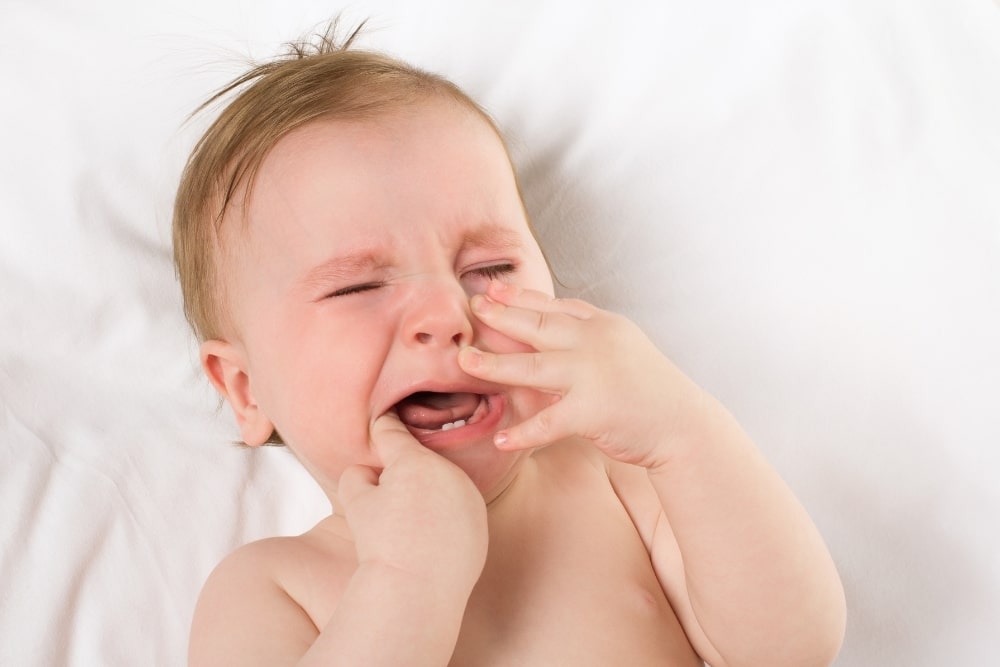
Being grumpy and unapproachable is another sign of inadequate sleep in babies and toddlers
Have you ever met a child who is downright grumpy, not liking to be around anyone, and throws ugly tantrums for mom or dad? This sounds a lot like a child who is having big trouble sleeping through the night.
Babies and toddlers, well into childhood have a difficult time expressing that they’re feeling tired.
Kids don’t really take kindly to ‘missing out’ all of the fun that goes on during the day – so the last thing they tend to think about is how tired they feel.
It’s incredible actually how kids can just keep going once they’re sleep-deprived, they will do anything they can to get out of naptime. Even though your child doesn’t take fondly to naptime, it doesn’t make it any less important.
Chamomile tea can induce better naptimes if your child drinks it during the day. On a day that your child seems more grumpy, ask to have tea time to get some beneficial chamomile into their body.
Rest is crucial to having a good mood, even as an adult, I need adequate sleep to be in the best mood.
If I miss out on getting enough hours of sleep, or I don’t rest when I need it – I can find myself feeling off or even more moody than I would’ve been otherwise.
Children need to rest, even more, than an adult does. Pay attention to your child’s behavior and overall mood, they might be indicating how they aren’t sleeping well at night in unexpected ways.
If your child is prone to teeth-grinding, it might be time to focus on better sleep
View in gallery
Teeth grinding can begin at any age, taking root and tagging along for many years in your child’s book of bad habits. Don’t blame your baby or toddler if they start grinding their teeth though, this can be a sure sign of poor sleep hygiene.
Babies start getting teeth around the age of 6-month usually, and can indeed grind their baby teeth or adult teeth once they start to grow in. If there are teeth in your baby’s mouth then your child can grind their teeth.
Keep in mind that some babies do this because they’re teething and it’s causing them pain.
If your baby is grinding their teeth while sleeping, this is also a sign of a sleep disorder. Chamomile tea can help induce a deeper – more rounded sleep pattern for your child.
If your toddler has an irregular breathing pattern while sleeping it can mean they aren’t sleeping as good as they could be
Snoring and unexpected pauses in your baby’s breathing throughout the night indicate a possible sleep problem.
One thing that chamomile is really good at doing is calming the nervous system – decreased oxygen flow while sleeping can cause unnecessary stress on your child’s nervous system – thus causing snoring, or pauses in their breathing.
Pauses in a child’s breathing usually happen in the REM cycle of sleep which is the deepest sleep cycle, though these pauses can be normal as well.
If you’re unsure of whether the pauses in breathing your baby or toddler is taking while asleep then be sure to contact your child’s pediatrician to ask about their breathing pattern and using chamomile tea to calm your child’s nervous system before bedtime.
If it’s difficult to wake your child up in the morning on a regular basis, it’s a sure indicator of poor sleep
View in gallery
Poor sleep goes hand-in-hand with not wanting to wake up in the morning. Some kids need a day to sleep in late here and there.
But, if you find that your baby is hard to wake up in their morning more than a few times randomly, it can mean that sleep hasn’t been optimal for him or her.
You will need to ask yourself if your child is going through a growth spurt or if they seem to be sleeping extra all of the time.
After you’ve decided if this is normal for their unique sleeping pattern, then you can decide if you would deem their sleeping in as a ‘sleeping problem’ that needs to be treated.
If you feel that your baby is sleeping in due to sleeping poorly throughout the night – opt for a dose of chamomile tea in the early evening hours. That way they can get to bed earlier that night.
How can poor sleep affect my baby or toddler in their daily life?
We can all agree that poor sleep wreaks havoc on the nervous system and growing cycle for young children.
Babies and toddlers seem to particularly have a much harder time thriving when their naps are interrupted or they don’t get enough hours of sleep in a given night.
Below are a few very important ways that disrupted sleep can cause negative effects in your child’s daily life;
Children who don’t get enough sleep may have poor concentration
It’s hard enough to concentrate as a young child when there are so many interesting things happening in life already. Yet, babies who get too little sleep have a far harder time concentrating on tasks at hand.
Even following a conversation, or learning a new word can be increasingly difficult when a poor sleep routine interferes with daily function. Concentration in young children works well by using their ventilation system efficiently.
Experts have found that babies or kids who are given space to ventilate their energy well focus better on the upcoming task at hand.
View in gallery
This means that a child who has had better sleep the night before will naturally have enough patience and proper ventilation of energy, overall managing their concentration the best possible.
If a child hasn’t had good enough sleep, they will not be able to handle the intense amounts of energy that come with having to focus and exert extra energy in order to continue focusing well.
Babies who don’t get good sleep might have performance issues and or slowed reaction times
Besides good nutrition, a good amount of sleep is required for your little one to act and react physically. For instance, someone on a sports team would perform poorly if they were too tired to kick the ball or swing a bat.
This is the way it is for young children except the action happens through daily functions; picking up a cup to drink it, or putting on their shoes.
If your child doesn’t receive enough sleep they might react slowly or spill a lot and have poor motor skills across the board.
Babies need sleep for their brain to tell their body what to do – and since chamomile is prized for helping improve sleep function – offering it to your small child can have a great impact on their system.
Chamomile tea flowers and leaves can help heal your babies cuts, burns, and scrapes
Though uncommon, babies can have a small scrape or gain a sunburn. Babies sunburn especially easily, and I could definitely envision a toddler falling down and getting a scraped knee.
When these external ouchies or wounds happen to the skin, you can count on chamomile tea to help promote healing.
View in gallery
To use chamomile on your baby’s scrapes or to promote healing to the skin in general, simply brew an extra-strong batch of chamomile tea and then soak a rag in it(at room temperature or cold) and place the rag over the wound or sunburn.
Be sure to soak the rag on the skin for as long as possible. Surely your child will out-move the rag off their body before 20 minutes passes by… so just go with it.
This can be a fun way to introduce using herbs to heal the body to your child at a young age.
Make sure to use the tea within a few hours of brewing it, and never re-use tea that has been sitting out as this can introduce bacteria to the wound rather than promoting healing.
Clean any open wounds prior to placing a cold compress over them.
Chamomile is commonly used to treat colic in babies
If your life is deemed chaotic and stressful due to a baby who has symptoms of colic, then you can resort to chamomile. This tea is filled with calming abilities for colicky babies.
According to Medicalnewstoday.com, colic happens when there is an imbalance or pain in the abdomen of a baby. This can happen when the digestive enzymes or bacteria are compromised, causing upset stomachs and cramps in the digestive tract.
Think heartburn, bloating, or pain in the internal organs near the stomach or renal region. A baby with colic might cry for longer periods of time, become frustrated easily, or have interrupted sleep, eating, and feeding routines.
Colic is generally harmless, but it can cause a great deal of frustration to both the parents and the baby who is colicky. You will want to treat your baby for colic because their crying can seem long and intense during a bout of pain.
View in gallery
The most common types of colic are the following:
- Renal colic (caused by kidney stones)
- Horse colic (caused by one of the many diseases in horses)
- Painter’s colic (caused by lead poisoning)
- Biliary colic (caused by a gallstone obstructing a cystic duct in the gallbladder)
Since there are so many different types or causes of colic in babies, it’s important to have your baby be seen by a professional if you suspect your little one to have colic.
A pediatrician or children’s doctor can help guide you through helping your baby feel better.
Each of the various types of colic affects a specific region of the body within a baby – for instance ‘renal colic’ usually occurs due to painful kidney stones.
Chamomile can effectively soothe your baby’s nervous system during a bout of pain or other undesirable symptoms.
Dosing your baby in small increments of chamomile tea a few times throughout the day is the best way to avoid an upset stomach when treating colic.
At what age can my baby drink chamomile tea?
Six months of age is a good timeframe to begin allowing your baby to drink chamomile tea. At this age, food has already been introduced, and your baby is getting the hang of welcoming new flavors of food and drink on their pallet.
So as long as your baby has eaten or drank other kinds of nourishment outside of strict breastmilk, they can have chamomile tea safely.
Some babies might not like the taste of chamomile tea by itself, so it’s best to try it completely cold or inside of another drink they already like to have.
View in gallery
Chamomile tea teething popsicles are a practical way to serve soothing chamomile tea in a way your baby will love
This recipe is borrowed from projectnursery.com and is perfect for babies 6-months of age and older.
These delicious strawberry chamomile tea popsicles are a wonderful way to realistically implement chamomile into your baby’s diet – babies love ice-cold popsicles on their teething gums.
Relax and soothe your baby with a refreshing popsicle filled with antioxidants and minerals in the tastiest way possible. Popsicles are especially great when your baby is teething and or the summer season when it’s hot outside.
First, you need the following ingredients:
- 2 cups of boiling water
- 1 chamomile tea bag(caffeine-free)
- 10-12 frozen strawberries
To prepare: Just like you would brew any regular cup of chamomile tea, you will boil the 2 cups of water and place the teabag in it – be sure to turn off the stove while the tea is steeping.
You’ll need to cut the leaves off of the strawberry top, afterwards, you’ll need to puree fresh or frozen berries. Until a chunky liquidy version of them exists. This is sometimes called muddling as well.
After the tea has cooled to room temperature, you can pour it into the mold until it has ⅓ remaining free for the strawberry puree.
After the tea is filling 2/3rd of the popsicle mold, you will then place the strawberry mixture on top of the liquid and close the mold or place a popsicle stick in as needed.
Freeze overnight and enjoy with your teething baby the next day!
View in gallery
There are a few ways to offer a fresh brew of delicious chamomile tea for your baby
You can go cold or lukewarm with offering your baby chamomile if you ask your baby what’s preferred. I can bet it’ll depend on the day! Somedays when babies are teething, they can be really hot and even run a slight fever.
On these day’s babies might seem extra fussy and sweat more than usual – on the days your baby is feeling hot – a popsicle might be quite soothing for their gums.
On the other hand, some days a teething baby can have a slight headache, in which they would be much more sensitive to a frozen food item – on these days lukewarm chamomile tea in a cup is the best way to offer this drink successfully.
You don’t want to offer the tea while it’s still steaming hot, in fact, you might want to brew a cup and then add a bit of cold water to it.
That way it will truly be the perfect temperature throughout the entire cup of tea – be sure to mix it a few times and stick your pinky finger inside the tea to test the temperature of the liquid.
Your baby will let you know if they want it or not, teething babies are pretty outspoken about their needs. Be sure to communicate what it is to them, and listen to what they have to say about chamomile tea.
Start your baby off with just a few tablespoons of chamomile tea
View in gallery
Start your baby off with just a few teaspoons or tablespoons when you first introduce it.
It’s highly unlikely that your baby will want to drink copious amounts of tea at such a young age, but it’s best to breastfeed before you offer any tea to your baby.
Giving your baby some breast milk to have in their stomach will enhance the benefits of the tea while ensuring that the chamomile tea is less likely to have adverse effects on your baby such as dehydration or vomiting.
Babies don’t generally need to have chamomile tea daily, because the positive effects do last a few days.
Your baby’s body will begin absorbing minerals and nutrients as soon as they drink the tea, these minerals have lasting effects after consuming.
You can offer chamomile daily until your baby consumes it in a decent amount, and then you can switch to offering tea every 3rd day at full strength. Babies are incredibly sensitive to what goes into their bodies.
Too much of anything won’t feel good to them, and too little one won’t grant the benefits you’re looking for. Offer 2 tablespoons every 3 days to establish your and your baby’s routine.
Chamomile has been known as a healing herb for centuries because of the potent minerals it contains
One of the most widely known healing herbs to exist today – chamomile is used for sleep disorders, anxiety disorders, and even emotional imbalance as a well-rounded herb that keeps on giving.
The nutrient-dense herb chamomile is prized for the way it helps ease anxiety through its calming properties. In babies, chamomile tea can improve digestion, soothe sore gums from teething, and promote a good mood in your little one.
View in gallery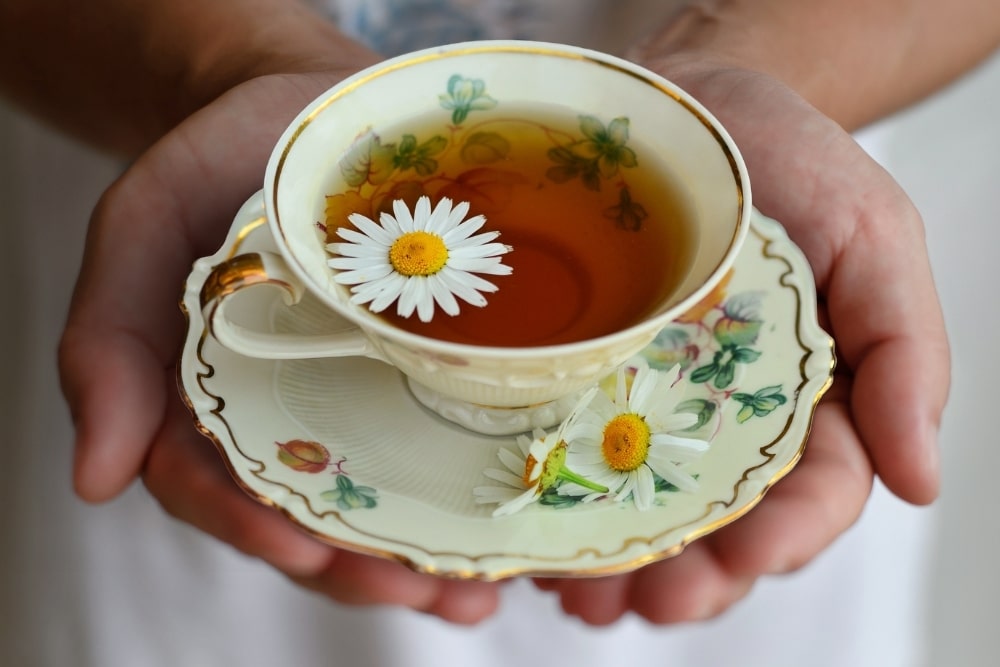
Contains the following minerals and vitamins (you can see why it’s so beneficial to your health):
- Vitamin A
- Calcium
- Vitamin B12
- Iron
- Potassium
- Carotene
- Folate
What is tea? Are all teas created of equal quality?
Did you know that tea is the runner-up of the most consumed drink in the world?
That’s right it’s brewed in almost every culture around the world in copious amounts. I mean, I’ve never met anytime who doesn’t like at least one flavor of tea – have you?
Tea has long been a piece to various cultures around the world, but exactly where it originated is given credit to Asia. Asia is where the camellia plant first grew, which is the same plant that all types of tea are concocted from.
Every flavor like black, green, oolong and more stem from a different part of the camellia plant.
Native to Asia, it quickly spread around the world, for tea lovers abroad. This plant is a sub-tropical evergreen that grows wildly, in abundance.
You can probably spot it in botanical gardens all over the place. Making it one of the hardiest plants around for a man to utilize.
View in gallery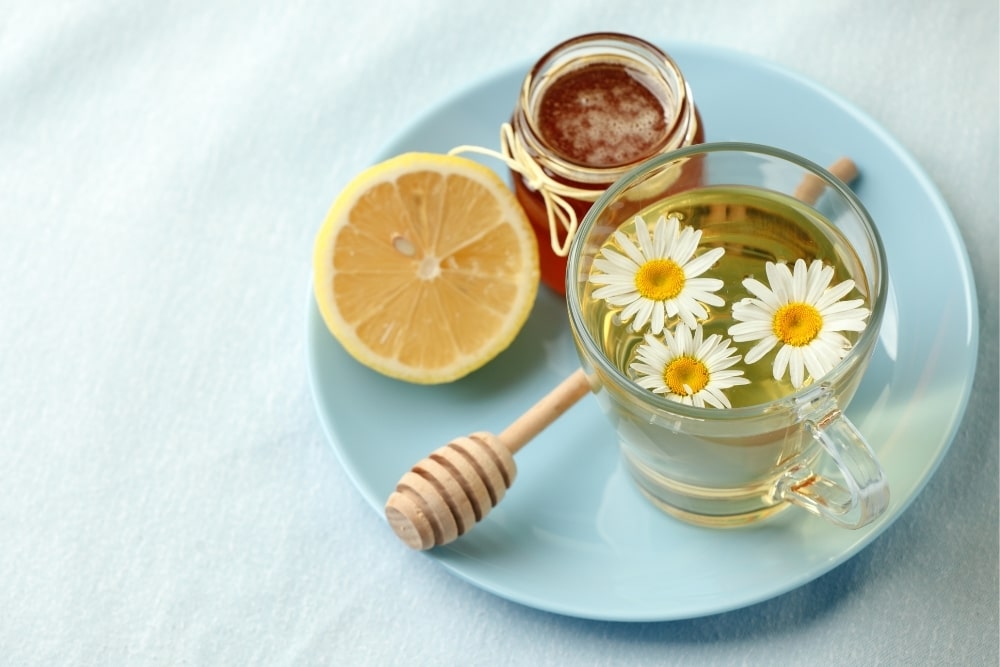
The scientific name for the chamomile plant is Camellia Sinensis
Grown best at higher altitudes, Camellia Sinensis produces new tea leaves every year – hence the name – evergreen.
It grows in abundance with few resources, this is because of the fertile vegetative leaves that naturally appear all over the camellia plant.
Really, tea is any part of the camellia plant; leaf, stem, or otherwise that can be then brewed as a drink for human consumption.
You might be wondering how there are so many flavors of tea – if it comes from one plant. That is a good question. Read onward…
How is any type of tea produced?
Tea has a long and interesting process to undergo before it reaches your taste buds. Tea has to go through various stages of cleaning, plucking, and drying before it can reach your favorite mug.
While there are many different companies that produce and sell tea bags in the grocery store or otherwise. The process of creating the perfect tea is relatively similar for each company.
In the first 24-hours after picking off the tea leaves, it must already be decided whether the tea is going to be decaf, black, flavored, etc…
After sorting the edible (or desired) pieces of the camellia plant, each batch will be well on its way to what the end result will be for it.
View in gallery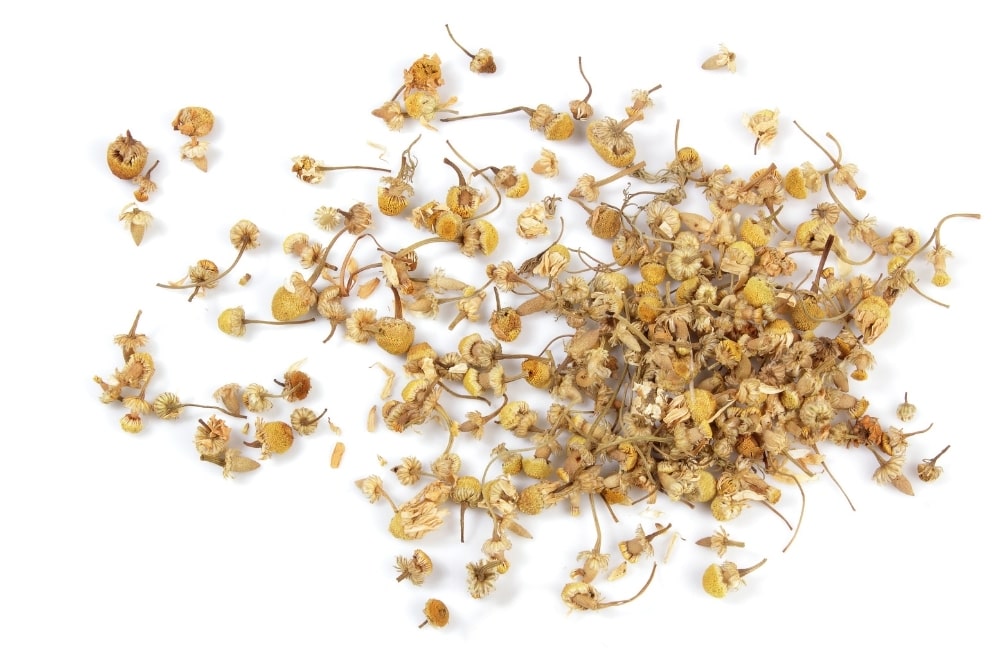
First, the tea leaves are sorted out to prepare the individual batch the leaves will belong to
All camellia tea leaves or parts of the plants are sorted in the initial stages of tea making.
This is done by sorting the leaves according to the size they are when fresh. Big leaves will dry at a different rate than the smaller leaves.
Thus, the leaves must be sorted accordingly – so they can dry at a proper rate – batch by batch. Most companies sort their tea leaves through a process called grading.
Grading occurs when tea leaves are rated according to the size they are as well as the quality they behold.
For instance in China tea leaves are rated on a scale of 1-6. With this rating system, a #1 rating is the best quality and the largest leaves, while a #6 will be the smaller lower-quality leaves or even crumbled leaves.
An example of the size ratings as well as the type of rating for tea leaves are carefully considered when rating tea leaves
Large tea leaves might be anywhere from 7-11mm in length, this measurement is calculated when the tea leaf is carefully twisted to provide the longest measurement of the leaf.
This size and type of leaves are carefully rubbed and twisted upon measuring. The tip of the tea leaf is included with the measurement.
View in gallery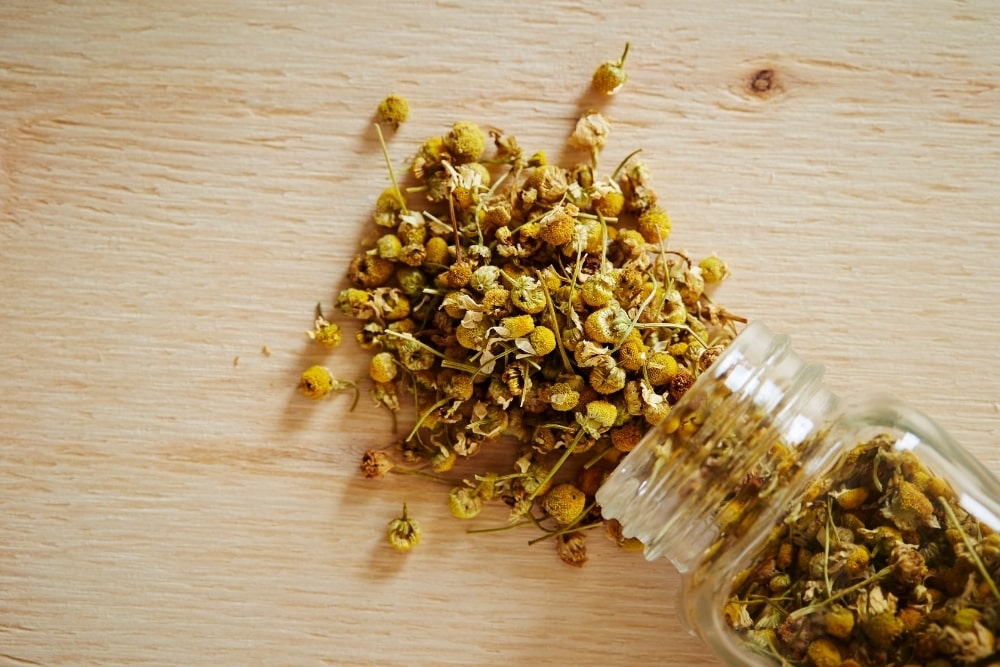
Another name for the longest tea leaves is ‘OP’ or orange pekoe, this any part of the tea leaves that are large and not broken. On the other hand, ‘BOP’ leaves are broken or cut intentionally.
Medium tea leaves will probably extend to roughly 2-4mm in length and can be naturally that size or they’ll be the original OP leaves cut in half.
Since natural leaves are usually smaller in size, tea leaves will mostly range from this size right off of the plant. ‘BOP’ stands for broken orange peco or BP stands for broken peco.
If you see this term regarding the tea you’ve bought then you’ll know it’s tea leaves that are the same quality as OP leaves simply cut into smaller chunks and induced with more stems.
A low-quality tea that you might prefer to upgrade before sharing with your little one, are the teas that use a method called the CTC method.
Tea made using this method is the most easily extracted of any method – but it does include finely ground dust particles from the tea leaves.
Though some tea that is labeled as broken tea or BOP does contain the lowest quality of tea leaves, due to the dust from fanning the leaves and otherwise broken tea leaves: being included in the final teabag.
It’s hard to get out the dust from such small or broken parts of the tea leaves. So many of the BOP-labeled teas are not the best quality.
View in gallery
The CTC system is another way of sorting various types of tea leaves based on the appearance and traits of the leaves
We’ve discussed the size rating system for producing tea. Now let’s discuss another method of sorting tea leaves called the CTC method based on the appearance and traits of specific groups of tea leaves.
The CTC method is the rating system used most commonly across the world. Tea leaves that appear to be broken, dusty, or finely ground all go into the CTC method.
This method is a way of including all parts of the tea leaves regardless of the quality or size, and often included is the finely ground dust parts of the dried tea leaves.
The reason that the CTC method is the most commonly used everywhere is that it is easy to extract highly aromatic and strong tea from all of the parts.
Knowing where your tea comes from and how it is sourced is the key to offering your baby safe tea
The goal is to always know where the food and drink that your young baby is drinking comes from a quality source.
You have the choice to purchase a tea that you know hasn’t been sprayed with pesticides or has artificial additives in the tea leave mix. You have to be proactive about your baby’s food source.
Otherwise, a baby can have negative reactions to a chemical that was used in the production of tea leaves – rather than the tea itself.
View in gallery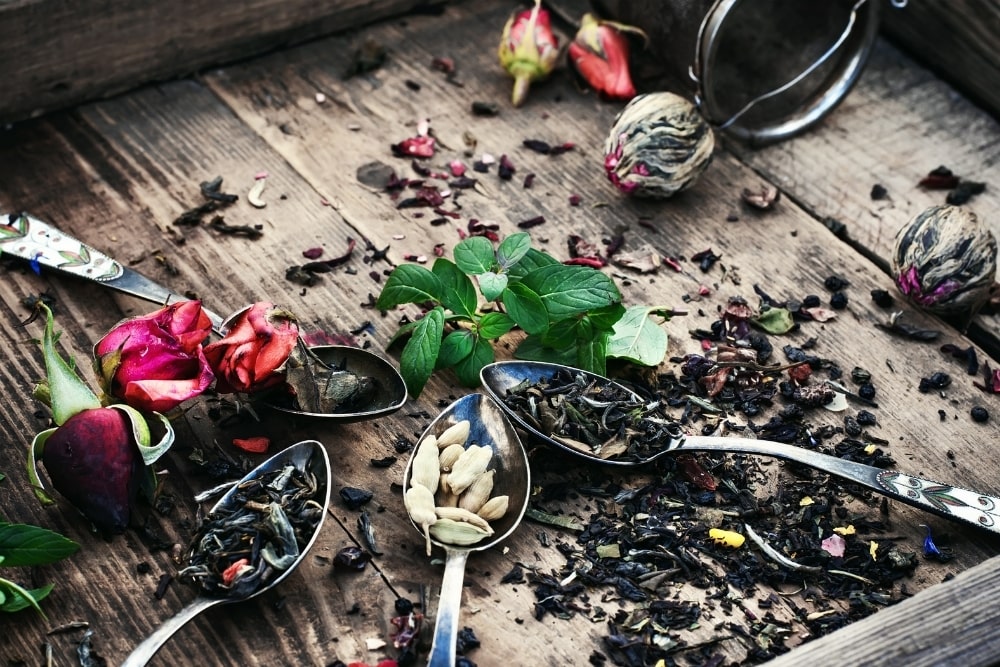
Finding organically grown tea leaves is one of the safest ways to purchase high-quality tea, though some good quality tea companies don’t yet have the organic label but are still of good quality.
That said, you can purchase organic or non -organic chamomile tea for your baby, just be sure to do a bit of research about the company you plan to buy from.
If you know a bit about the company, you’ll have peace of mind when introducing this tea to your little one.
In Conclusion
Chamomile tea can be highly beneficial for children and young babies, helping with many undesirable ailments, from insomnia, pain from teething, and moderate to severe colic.
You can implement chamomile tea in a variety of ways to compliment your baby’s diet.
The benefits of drinking tea have long been utilized in cultures across the globe and are becoming even more prevalent today with even more in-depth research coming to light from science and human experience.
Parents don’t mind giving their children tea, now that they know other parents already are doing so with good outcomes.
Chamomile is one of the most welcoming tea varieties that exist today. It doesn’t matter what age or state of health a person is its gentle effects on the digestive system make it a good choice for anyone.
Sources
Children Sleep Problems – WebMD
Chamomile Tea for Babies, is it safe? – Parenting






